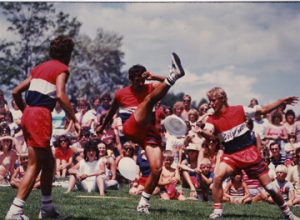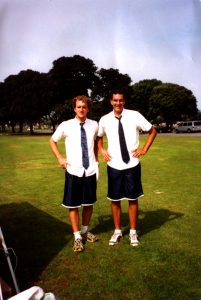 When I competed in my first event in 1996, The Beast took me under his wing and taught me how to think about competition. Since we had only met the day before we came up with 3 co-ops for the routine. That was 3 more than I had ever come up with before. From there, my routine preparation slowly grew towards more choreography.
When I competed in my first event in 1996, The Beast took me under his wing and taught me how to think about competition. Since we had only met the day before we came up with 3 co-ops for the routine. That was 3 more than I had ever come up with before. From there, my routine preparation slowly grew towards more choreography.
At the 1999 FPA World Championships, Matt and I had 4 opening co-ops. Then we went “spon” until a “half way” time call. We had 2 co-ops for that. Then “spon”, finishing up with 2 co-ops at a “30 seconds” time call.
 At the 2001 FPA World Championships, Matt and I had every moment of the routine planned out, with the exception of our 4 indies. No time calls where needed. At the time, that was our best finish, 4th.
At the 2001 FPA World Championships, Matt and I had every moment of the routine planned out, with the exception of our 4 indies. No time calls where needed. At the time, that was our best finish, 4th.
Based on that experience, it might seem that fully choreographed routines are the way to the top. However, I have also had many successes that were 100% spontaneous. Matt and my first win at California states, for example, or recently at Frisbeer 2013. Never won and FPA worlds without choreography though.
After listening to Bill talk about the Coloradicals journey towards choreography, hearing the various approaches of the teams at Frisbeer 2017, and reflecting upon my own history, a question comes to mind.
When you compete, how much of your routine is planned ahead of time?
[poll id=”7″]
Tell us in the comments, do you think choreography increases a team’s chances of doing well?



i do think it very much helps
i think it helps very much
I would like to see more “spawn” routines rewarded as that reflects better what jamming is all about.
Playing indoors so that routines can be realized should be saved for exhibitions. Competition should be about adapting to conditions and partners as this is what we do when we jam. Competitions should reflect what the sport is all about. This would also open it up to more competitors. Not everyone lives near other top competitors so they are at a disadvantage or maybe the top person near you is already paired up, what do you do? Quit? So lets make tournaments more about including as many as possible in spontaneous formats with random pairings. This does seem to be a long way aways from where we are now but where is that? Are we really drawing in new participants? Since we are not competing for money or fame then lets reevaluate what do we want the sport to be.
The content and “touch” of a routine isn’t solely depending on whether it’s choreographed or not. You can choreograph it to look spontaneous and vice verse. It has always been the choice of players’ to perform what they like and some have had an emphasis on “goin’ for” winning tournaments. However the later choice doesn’t necesarilly lead to getting more points….winning tournaments. For instance the current judging system simplifies a.i. by using the no of co-ops to determine co-op work. Look at some of the co-op routines of WFC 1981 – Coloradicals and Rhodes/Felberbaum/Elliot and Hudoklin/Jewell/Smiths. The routines contain lot’s of co-ops and a lot of indies. Good choreography and difficulty on both. Flow, moving around, playing to the music as a whole and not “hitting” a few cues. The were mostly choreographed but it doesn’t feel like it’s limiting the experience of the performance. As a whole I think these routines are better than the winning co-op routines of today. It’s true that the competive scene was different; more players on a very high level and relatively young (<30 years old). I quote Z Weyand who often adress the issue. We need to get more people to our sport, to come out and play. It really doesn't matter (that much) who wins but we must of course have a system that we can use at tournaments. The people using it must have a general understanding of what moves/coops/other elements receive a certain score. I look forward to see all jammers competing or not: choreographing or not….